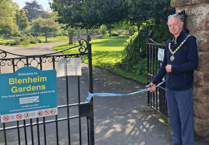A BID to build a solar farm almost the size of Washford on land owned by the Wyndham Estate could fall foul of planning policies designed to protect the countryside.
Members of West Somerset Council's planning committee will be recommended to refuse the application by TGC Renewables when they meet next Thursday (September 26).
The firm wants to install 35,200 solar panels on 50 acres of land at Aller Farm, east of Woodford and north of Monksilver.
The development would generate 8.27 megawatts of electricity, enough to power 2,281 homes and would also come with security fencing, CCTV and on-site power units.
But planning officers will advise committee members to refuse planning permission due to the impact the solar farm would have on the surrounding landscape, particularly the protected countryside in the neighbouring national park and nearby Quantock Hills.
Officers will also advise councillors that insufficient information has been submitted to prove the development will not adversely harm the character of the area, while more investigations need to be done to establish if there is any archaeology on the site.
The application has attracted a groundswell of objections from numerous parish councils, both the Quantock Hills AONB service and Exmoor National Park Authority, as well as from 15 individual residents.
Two letters have been sent in support of the development, which TGC Renewables is adamant would be well-screened and would only have a limited impact on the surrounding countryside.
The firm said it had considered other sites but the chosen plot was deemed to be the best for a variety of reasons.
In its planning application to West Somerset Council, TGC Renewables said: "It was decided to proceed with a proposal at this location due to the land's orientation, it being well screened ensuring minimal landscape impact, there is a good separation distance between residential properties and protected buildings/landscapes, good access links and proximity to grid connection.
"The proposal development will be well contained and not cause a significant or unacceptable detrimental visual impact as demonstrated by the landscape and visual report submitted with the planning application.
"The proposal will create an environmental and economic benefit by providing renewable energy.
However, the solar farm - the district's first large-scale green energy development - would be visible from the Quantock Hills and Exmoor, as well as numerous villages, including Bicknoller and Stogumber.
The company said public reaction to its plans had been positive at a recent consultation event, but accepted some people had concerns about its visual impact.
Half a dozen parish councils have objected to the application which, including the host parish of Sampford Brett.
Sampford Brett Parish Council chairman Jan Swan, said: "Our primary concern relates to the visibility of the site which is in an elevated position with expansive rural views in all directions.
"The proposed development will cover 20.26 hectares of agricultural land with solar panels which will be visible from both Exmoor National Park and the Quantock Hills AONB.
"We accept that the views from these locations will be relatively distant, but anticipate that they will, nonetheless, be out of keeping with the very rural character of the area.
"At a closer distance, the panels will be clearly visible from the two houses at Jacobs Pond and from the Sampford Brett to Monksilver road.
"Closer still, the panels will be adjacent to the Coleridge Way bridleway and very near to the Coleridge Way footpath, both of which are important recreational routes."
Cllr Swan said there were real fears the development could cause flooding problems on local roads and have a detrimental impact on tourism as many visitors came specifically to enjoy the countryside.
TGC Renewables maintained the solar farm would only have "very limited impacts on the landscape" and pledged to plant even more trees in what they described as an already well screened area.
"[The solar farm] will only be intermittently overlooked from the high ground of the AONB to the east and only partially from the national park to the west where, although perceived, will be a relatively minor built element set within an expansive rolling agricultural, well vegetated landscape," the firm said.
If approved, the solar farm would remain in situ for a maximum of 25 years, before being removed and the land returned to sole agricultural use.



Comments
This article has no comments yet. Be the first to leave a comment.